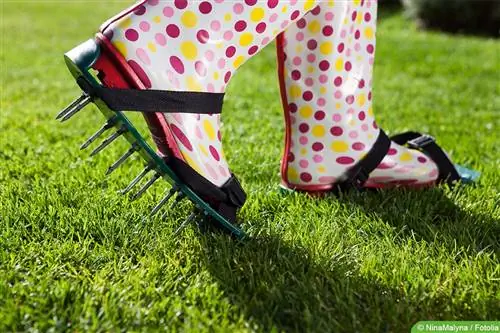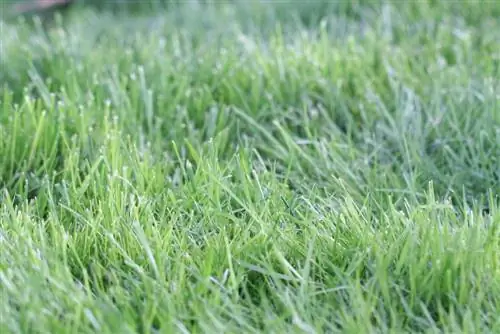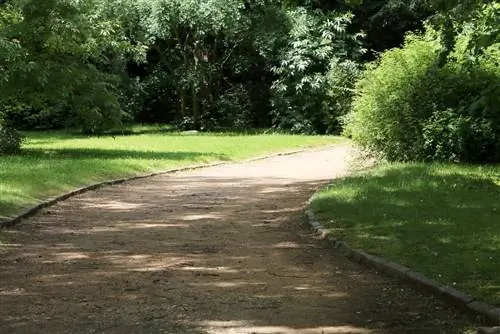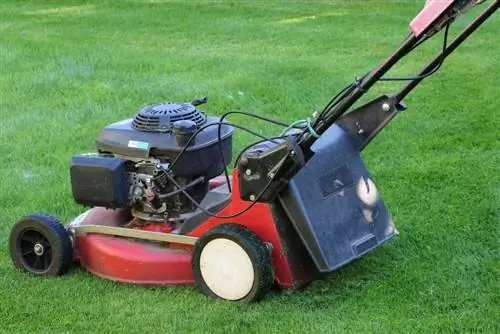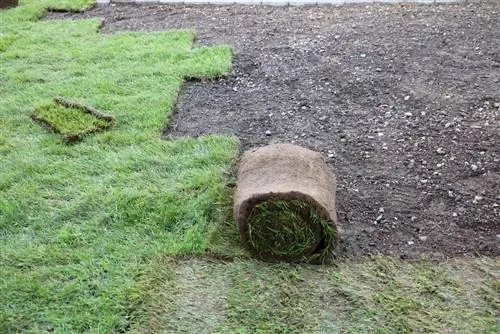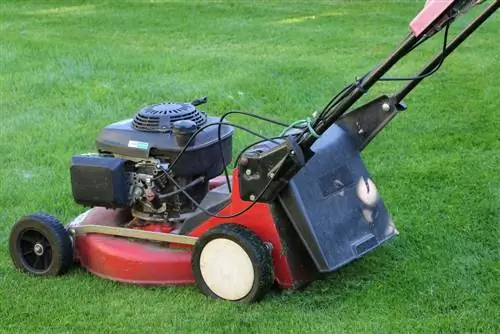- Author admin [email protected].
- Public 2023-12-17 03:39.
- Last modified 2025-01-24 12:45.
Over time, the lawn soil becomes compacted so that the grass roots no longer get enough air. That's why regular ventilation, also known as aerating, makes sense. But when is the best time for this?
What is ventilation?
The term “aerating the lawn” is understood by the gardener as drilling holes in the upper soil structure, for example with a digging fork or a special aerator. These are aids or devices that are intended to aerate the soil, such as shoes with spikes (“lawn aerators”) or a hand aerator. Aerating is intended to loosen up compacted soil so that water and air reach the grass roots again and the lawn grows better.
Reasons for ventilation
Stressed lawns in particular become compacted over time. This primarily includes areas that are designated as
- Sports turf
- Play turf
- Walking or lying lawn
used and therefore frequently accessed. This means that the top layer of soil becomes more and more compressed and loses its looseness. In such soil, the grass roots can no longer spread properly, and rainwater accumulates on the surface and no longer seeps into the deeper layers. The result is that the grasses are only inadequately supplied with moisture and nutrients. Weeds and moss are increasingly spreading and displacing the lawn.
Tip:
You can tell whether your lawn soil is compacted by the puddles that form after a rainstorm: If the water remains on the surface for a long time and only seeps in slowly or not at all, it is high time for aeration.
Best time
The growing season begins in spring. After the long winter rest, the plants put most of their energy into developing new shoots and roots. So that they can grow and thrive he althily until autumn, they need good care and support in early spring. For a lawn this means:
- lime in autumn
- mowing for the first time in March
- scarify
- aerify
- fertilize
The best time to aerate is after mowing the lawn for the first time, as the grass is then nice and short and you can loosen the soil better. Scarifying also only takes place after the first mowing and should take place before aerating.
Note:
Dethatching and aerating are two fundamentally different things, even if they both have the goal of improving lawn aeration. When scarifying you remove moss and thatch, while aerating you make holes in the ground.
Frequency
In principle, aerification can also be carried out more frequently per year, depending on how compacted the soil is.
- Aerification possible all year round
- first time in spring
- for heavily compacted soils, another time in summer or autumn
- never aerate after heavy rain
- not even in longer dry periods
After a heavy downpour or during a rainy period, you should avoid aerating, as the soil can become muddy and become even more compacted.
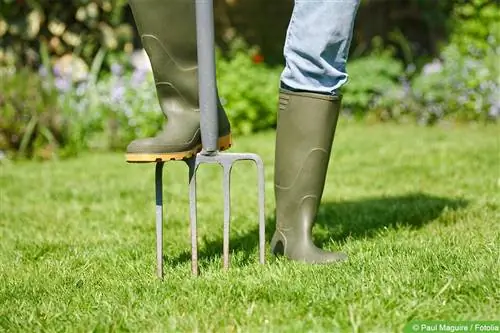
During longer dry periods - such as those that occur in midsummer - this measure is also not recommended. Now it would help the remaining moisture in the soil to escape even faster and you would have to water the lawn more often.
Procedure
So that your lawn will soon shine in fresh green again, it is best to do the first spring care between March and the beginning of May as follows:
- Mowing the lawn: not too short, optimally four centimeters of grass length, do not mulch
- Dethatching: with rake, hand or electric scarifier, only on dry lawns
- Aeration: with lawn aerator shoes, aerator fork (aeration fork or hand aerator), lawn aerator roller or electric aerator
- Fertilizing and watering
When aerating, make sure that the ventilation holes are made evenly and about ten centimeters deep.
Tip:
There are combined devices on the market that allow scarifying and aerating with one device. Here, the blade attachment of the scarifier is replaced by the thorned aeration roller. These helpers are particularly practical on larger lawns.

